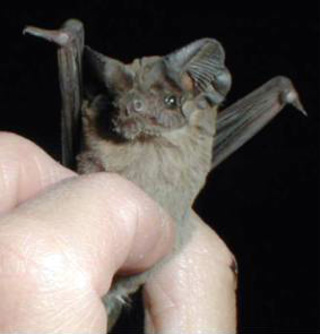
Brazilian free-tailed bat
Order : Chiroptera
Family : Molossidae
Species : Tadarida brasiliensis
The Brazilian free-tailed bat is listed as Near Threatened (LR/nt), is close to qualifying for or is likely to qualify for a threatened category in the near future, on the IUCN Red List of Threatened Species
Namings for the Brazilian freetailed bat
A young / baby of a Brazilian freetailed bat is called a 'pup'. A Brazilian freetailed bat group is called a 'colony or cloud'.Countries
Antigua and Barbuda, Argentina, Belize, Bolivia, Brazil, Cayman Islands, Chile, Colombia, Costa Rica, Dominican Republic, Ecuador, El Salvador, Guadeloupe, Guatemala, Haiti, Honduras, Jamaica, Martinique, Mexico, Montserrat, Netherlands Antilles, Nicaragua, Panama, Paraguay, Peru, Puerto Rico, Saint Kitts and Nevis, Saint Lucia, Trinidad and Tobago, Turks and Caicos Islands, United States, Uruguay and VenezuelaSome facts about the
Brazilian free-tailed bat
Adult weight : 0.013 kg (0.0286 lbs)
Maximum longevity : 12 years
Female maturity :273 days
Male maturity : 547 days
Gestation : 78 days
Litter size : 1
Interval between litters : 365 days
Weight at birth : 0.003 kg (0.0066 lbs)
Body mass : 0.013 kg (0.0286 lbs)
Temperature : 35.85 °C (96.53 °F)
Facts about the Brazilian free-tailed bat
Brazilian free-tailed bats are found throughout the state, the roosting preferences for these very adaptable bats are barrel tile roofs, buildings, tree hollows and holes and man-made structures.
But the Mexican, or Brazilian, free-tailed bat is among the world’s most famous bats.
The Brazilian free-tailed bat is the smallest free-tailed bat in the United States.
" Brazilian free-tailed bats are found throughout southern North America, Central America and South America.
'94par }{plain f1 tab Brazilian free-tailed bats are found throughout southern North America, Central America and South America.
AGAINST THE desert sunset at Carlsbad Caverns National Park, the flight of the Mexican free-tailed bats (Tadarida brasiliensis) is a highlight for many visitors.
and the Southeastern Bat (Myotis austroriparius) by Bill Kern The Brazilian Free-tailed Bat is in the Family Molossidae.
Because of its limited distribution and declining population in Utah, the Brazilian free-tailed bat is included on the Utah Sensitive Species List.
Brazilian Free-Tailed Bat is far the most common throughout the southern US including all four southwestern deserts.
Brazilian Free-tailed Bat The Brazilian free-tailed bat is found throughout California.
brown bat, big brown bats and the Brazilian free-tailed bats are more apt to use bat houses.
However, the Brazilian Free-tailed Bat is smaller (total length 90 - 109 mm; mass 9.
Mexican Free-tailed BatThe Mexican Free-tailed Bat (Tadarida brasiliensis) is a medium sized bat.
Predators of Brazilian free-tailed Bats are hawks and owls.
The Brazilian free-tailed bat (Tadarida brasiliensis) is so named because its tail extends beyond its tail membrane (see photo).
Brazilian free-tailed bats are nocturnal, leaving their roost sites to forage at night. (Full text)
The Mexican Free-tailed Bat (Tadarida brasiliensis) is a medium sized bat. (Wiki)
com The Mexican free-tailed Bat Tadarida brailiensis Brazilian free-tailed bats are rather small bats with a wingspan of 290-325 mm. (Full text)
Distribution in Kentucky: Habitat and Life History: The Brazilian free-tailed bat is a highly colonial cave bat that has adapted to human structures, where many now roost. (Full text)
Discussion The Brazilian Free-tailed Bat is by far the most common bat in the Southwest; with a U. (Full text)
As a final indignity, it has also become apparent that while Brazilian free-tailed bats are insectivorous, they eat very few mosquitoes. (Full text)
Brazilian Free-tailed Bat ClassOrderFamilySpecies Mammalia Chiroptera Molossidae Tadarida brasiliensis Brazilian Free-tailed Bat Distribution, Abundance, and Seasonality The Brazilian free-tailed bat is found throughout California. (Full text)
by Alida Madero, TWO Latin American Coordinator The Mexican free-tailed bat (Tadarida brasiliensis) is a medium sized bat. (Full text)
Brazilian free-tailed bats are know to feast on moths at very high altitudes. (Full text)
More animals beginning with B
